
The rear naked choke (RNC) is a chokehold in martial arts applied from an opponent's back. The word "naked" in this context suggests that, unlike other strangulation techniques found in jujutsu/judo, this hold does not require the use of a keikogi ("gi") or training uniform.
An armlock in grappling is a single or double joint lock that hyperextends, hyperflexes or hyperrotates the elbow joint or shoulder joint. An armlock that hyper-extends the arm is known as an armbar, and it includes the traditional armbar, pressing their elbow into your thigh, and the triangle armbar, like a triangle choke, but you press their elbow into your thigh. An armlock that hyper-rotates the arm is known as an armcoil, and includes the americana, kimura, and omaplata. Depending on the joint flexibility of a person, armcoils can either hyper-rotate only the shoulder joint, only the elbow joint, or both the elbow joint and shoulder joint. Generally, armcoils hurt more than armbars, as they attack several joints at the bone and muscle.

In combat sports, the north–south position is a ground grappling position where one combatant is supine, with the other combatant invertedly lying prone on top, normally with their head over the bottom combatant's chest. The north–south position is a dominant position, where the top combatant can apply effective strikes such as knee strikes to the head, or easily transition into various grappling holds or more dominant positions. Transitioning into side control can be done by first switching into a particular hold known as ushiro-kesa-gatame (後袈裟固) or reverse scarf hold, where the chest points to the side, and the opponent's arm is controlled similarly to kesa-gatame. The north–south choke is employed exclusively from this position.
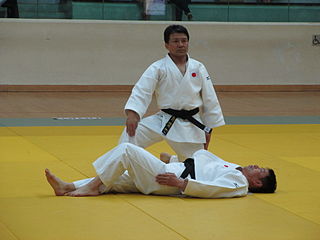
Katame no Kata is one of the two Randori-no-kata of Kodokan Judo. It is intended as an illustration of the various concepts of katame-waza that exist in judo, and is used both as a training method and as a demonstration of understanding.

Kata-Gatame (肩固) is one of the seven mat holds, Osaekomi-waza, of Kodokan Judo. It is also one of the 25 techniques of Danzan Ryu's constriction arts, Shimete, list. In grappling terms, it is categorized as a side control hold. Primarily used as a hold down in Judo, it is mostly used as a choke in Jiu-Jitsu and mixed martial arts. WWE wrestler Braun Strowman and former Impact Wrestling Superstar, Samuel Shaw use this move as their finishing maneuver.
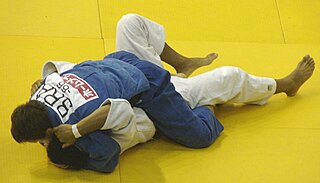
Tate-Shiho-Gatame (縦四方固) is one of the seven mat holds, Osaekomi-waza, of Kodokan Judo. In grappling terms, it is categorized as a mounted position.
Yama Arashi is one of the preserved throwing techniques, Habukareta Waza, of Judo. It belonged to the fifth group, Dai Gokyo, of the 1895 Gokyo no Waza lists. It is categorized as a hand throwing technique, Te-waza. It rarely occurs in competition or randori.
Gyaku Jūji-jime (逆十字絞), or gyakujujijime, is a chokehold in judo. It is one of the twelve constriction techniques of Kodokan Judo in the Shime-waza list. Danzan Ryu includes this technique in the Shimete list under the name Namijujijime. Ura-Juji-Jime is described in the Canon Of Judo and demonstrated in The Essence of Judo by Kyuzo Mifune.

Kata Jūji-jime (片十字絞) is a chokehold in judo. It is one of the twelve constriction techniques of Kodokan Judo in the

Tsurikomi Goshi (釣込腰), is one of the original 40 throws of Judo as developed by Jigoro Kano. It belongs to the second group, Dai Nikyo, of the traditional throwing list, Gokyo, of Kodokan Judo. It is also part of the current 67 Throws of Kodokan Judo. It is classified as a hip throwing technique, Koshi-Waza. Tsurikomi Goshi is also one of the 20 techniques in Danzan Ryu's Nage No Te list.
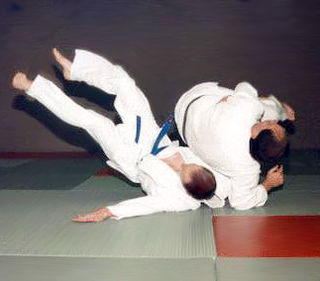
Soto Makikomi (外巻込) is one of the traditional forty throws of Judo as developed by Jigoro Kano. It belongs to the fourth group, Yonkyo, of the traditional throwing list, Gokyo, of Kodokan Judo. It is also part of the current 67 Throws of Kodokan Judo. Because tori takes a side fall next to uke, the technique is categorized as a side sacrifice technique, Yoku-sutemi. Danzan Ryu's Makikomi (巻込) is also one of the twenty throws in the Nagete list, which most closely resembles Soto Makikomi.
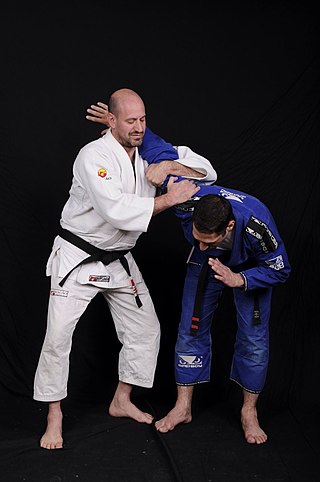
Ude-Hishigi-Ude-Gatame (腕挫腕固) is one of the official 29 grappling techniques of Kodokan Judo. It is one of the nine joint techniques of the Kansetsu-waza list, one of the three grappling lists in Judo's

Okuri-Eri-Jime (送襟絞) is one of the twelve constriction techniques of Kodokan Judo in the Shime-waza list.
Ryō-Te-Jime (両手絞) is one of the twelve constriction techniques of Kodokan Judo in the Shime-waza list.

Tsukkomi-Jime (突込絞) is one of the twelve constriction techniques of Kodokan Judo in the Shime-waza list.
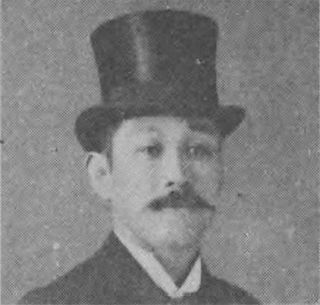
Mataemon Tanabe was a Japanese jujutsu practitioner and master of the Fusen-ryū school. He became famous for defeating multiple members of the Kodokan in challenge matches, and came to be considered one of the greatest modern jujutsuka.

Takisaburo Tobari was a Japanese jujutsu and judo practitioner. He was one of the earliest members of Kodokan.













